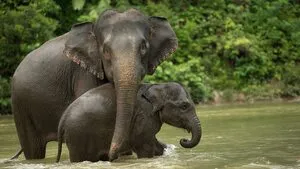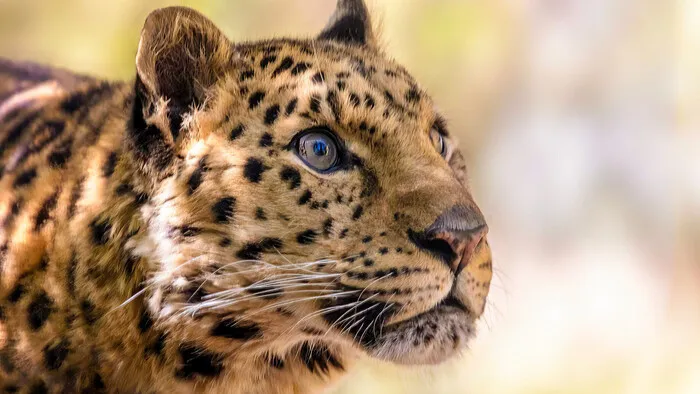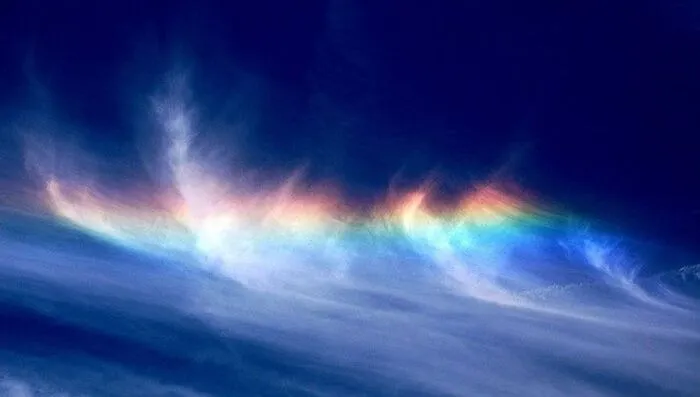The rapid decline of biodiversity worldwide poses a critical threat to the survival of numerous animal species. Human activities, including habitat destruction, pollution, and overexploitation, have accelerated the rate of species extinction to levels not seen in millions of years.
This crisis is a tragedy for the natural world and poses significant risks like affecting ecosystem services that support everything from clean water and air to food security and disease regulation. This article highlights ten animal species that are perilously close to extinction, discussing the unique challenges each faces and outlining actionable steps we can take to mitigate these threats.
Amur Leopard
With fewer than 100 individuals left in the wild, the Amur leopard is one of the world’s most endangered big cats. Native to the temperate forests of eastern Russia and northeast China, habitat loss and poaching are its biggest threats. These majestic animals are often targeted for their beautiful fur, and illegal wildlife trade further exacerbates their risk of extinction.
To combat these threats, conservation efforts must focus on habitat restoration and stricter enforcement against poaching. This includes increasing the area of protected land, enhancing surveillance and patrols in key habitats, and promoting community involvement in conservation efforts.
Vaquita Species in Danger
The vaquita is a small porpoise species endemic to the northern part of the Gulf of California, Mexico. With an estimated population of less than ten, the vaquita is the most endangered marine mammal. Illegal fishing practices that inadvertently capture vaquitas in gillnets have decimated their numbers.
The main culprit is the gillnet used for catching the totoaba fish, whose bladder is highly valued on the international black market. As a result, vaquitas are often caught and killed as bycatch. To combat this, conservationists are pushing for stricter enforcement of fishing regulations and the wider adoption of alternative, vaquita-safe fishing technologies.
Javan Rhino
The Javan rhino is a rare member of the rhinoceros family, with no more than 74 individuals remaining in Ujung Kulon National Park in Indonesia. This solitary species is at a critical juncture for survival, facing not only the risk of disease and volcanic eruptions but also the specter of genetic bottlenecking due to its small population size.
Protecting their habitat, expanding their range, and maintaining stringent anti-poaching measures are essential. Additionally, fostering community engagement in conservation efforts and exploring the possibility of establishing a second, secure population in a different location could enhance their chances of survival.
Help the Orangutans Species
Orangutans, found only in the rainforests of Borneo and Sumatra, are critically endangered due to extensive deforestation and habitat fragmentation driven by palm oil cultivation. Illegal logging and the conversion of forest land to agricultural uses further threaten these intelligent primates. Education campaigns aimed at consumers to choose products with certified sustainable palm oil can also drive market changes.
Conservation strategies include protecting existing forests through legal enforcement and community-based monitoring, restoring degraded lands to reconnect fragmented habitats, and promoting sustainable palm oil production practices that adhere to environmental standards.
Saola
Discovered in 1992 in Vietnam and Laos, the saola is a rare bovine species. Known as the “Asian Unicorn,” little is known about its ecology due to its elusive nature. This mysterious creature inhabits the Annamite Range’s dense forests, and it has rarely been seen in the wild. The saola’s population is under severe threat from habitat loss due to logging and agricultural expansion.
Moreover, the presence of snares set for other animals poses a dire risk, often resulting in unintended saola casualties. Protecting their habitat through the establishment of protected areas and stringent anti-poaching efforts, along with community education about the importance of the saola, are crucial for the survival of this enigmatic species.
Northern Right Whale
The North Atlantic right whale faces threats from ship strikes and entanglement in fishing gear. With only about 400 individuals remaining, the situation is dire. Efforts to modify shipping lanes and implement safer fishing gear practices are crucial to reducing mortality rates. In addition to these measures, enhanced surveillance and real-time tracking of whale movements can inform shipping adjustments to potentially avoiding fatal encounters.
International cooperation is also essential, as these whales migrate across borders. Conservationists advocate for stricter regulations and increased funding for research to develop innovative solutions that can coexist with industry activities. These integrated efforts are vital for the survival of this majestic species, ensuring that they remain a part of our marine biodiversity.
Kakapo
The kakapo, a flightless parrot from New Zealand, has a population of just over 200. Conservation efforts have included relocating individuals to predator-free islands and extensive breeding programs. The Kakapo Recovery Program involves monitoring of the birds, artificial incubation of eggs, and hand-rearing of chicks to ensure higher survival rates.
Additional measures such as genetic management are employed to enhance genetic diversity, which is crucial for the species’ long-term viability. Ongoing habitat restoration and predator control are essential to increase their numbers, and community involvement and awareness campaigns help garner support for these initiatives.
Sumatran Elephant: A Rare Species
Less than 2,000 Sumatran elephants remain in the wild, primarily due to habitat loss and human-elephant conflicts. As agriculture expands and forests are cleared, elephants are forced into closer quarters with humans, often leading to destructive encounters. Creating wildlife corridors can facilitate safer migration routes for elephants, reducing such conflicts.

Additionally, implementing conflict mitigation strategies such as community-based guarding programs can help protect this species. These programs involve local communities in conservation efforts, providing them with the training and resources needed to coexist peacefully with elephants, thus fostering a mutually beneficial relationship between humans and wildlife.
Chinese Giant Salamander
As the world’s largest amphibian, the Chinese giant salamander has seen its populations plummet due to habitat destruction and the demand for its meat. Pollution and infectious diseases also threaten these creatures, exacerbating their decline. Captive breeding programs and habitat restoration efforts are vital for its survival.
In addition to these informations, education campaigns aimed at reducing demand for salamander meat and promoting alternative livelihoods for communities involved in its trade are essential. These integrated conservation strategies are critical to reverse the decline of this unique species.
Hawaiian Monk Seal
Native to the Hawaiian Islands, the Hawaiian monk seal is critically endangered with a population of about 1,400. Main threats include food scarcity, human disturbance, and entanglement in fishing gear. Conservation measures include enforcing marine protected areas, community education programs, and rigorous monitoring and intervention efforts.
Initiatives such as seal rehabilitation programs and volunteer beach patrols help mitigate these threats. Promoting coexistence between seals and humans is essential for the survival of this unique species. Also, efforts to reduce marine debris and control invasive species further support their recovery in their natural habitat.


